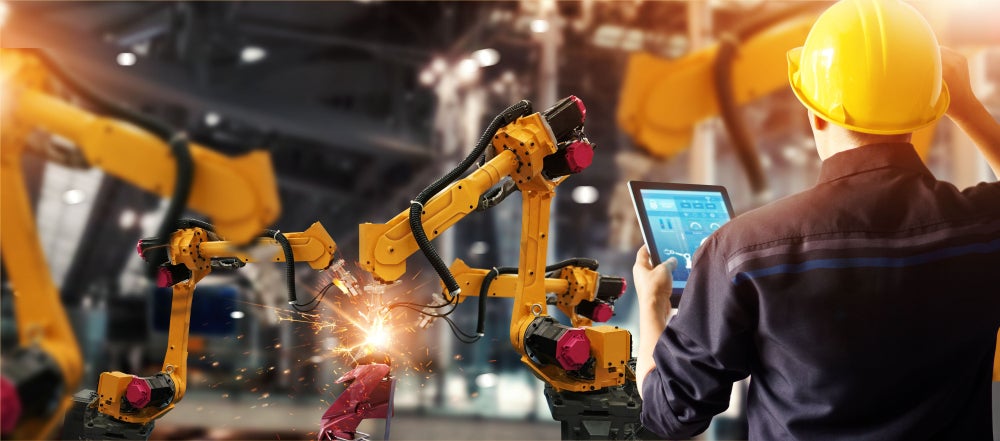The industrial internet, a market General Electric (GE) once predicted would account for $15 trillion of global GDP by 2030, is expected to redefine the way much of the global industrial economy operates.
It is part of a fast-evolving ecosystem of intelligent machines running their own logic and communicating with each other.
Development of this market, which GlobalData forecasts will be worth $145bn by 2023, is being driven by software, data analysis and artificial intelligence (AI) specialists who can make sense of the data being provided by the sensors that are at the heart of the industrial internet.
Industries such as manufacturing, energy, pharmaceuticals, utilities, and agriculture are the ones adopting such sensor and AI technologies that are driving a sea change in how such businesses are run.
Predictive maintenance will be a key use case, being able to track the wear on component parts, allowing manufacturers to lower their maintenance costs, extend equipment life, reduce downtime, and improve production quality by addressing problems before they cause equipment failures.
Who will be the key tech companies playing a key role in creating the industrial internet, particularly in the semiconductor space?
How well do you really know your competitors?
Access the most comprehensive Company Profiles on the market, powered by GlobalData. Save hours of research. Gain competitive edge.

Thank you!
Your download email will arrive shortly
Not ready to buy yet? Download a free sample
We are confident about the unique quality of our Company Profiles. However, we want you to make the most beneficial decision for your business, so we offer a free sample that you can download by submitting the below form
By GlobalDataGlobalData believes IBM, Qualcomm, STMicroelectronics and Texas Instruments are among the world’s leading semiconductor companies best placed to succeed in the industrial internet arena over the next two to five years.
Overall, rather than industrial giants like GE, leadership of this market is being assumed by software, data analysis and artificial intelligence (AI) specialists, who typically include Amazon, Microsoft and SAP. It is organisations like this who will be the ones necessarily making sense of the data the sensors generate.
The industrial internet, GlobalData suggests, is one of top ten themes that will impact the semiconductor sector, alongside data centres, artificial intelligence (AI), high-performance computing, ambient commerce, autonomous vehicles, gaming, 5G, M&A and geopolitics.
GlobalData’s latest ‘Semiconductor Scorecard’, analyses the major technology, macro-economic, and regulatory themes impacting semiconductor companies and reveals that Xilinx, Micron, ASML Holding, Analog Devices, ROHM, Aixtron, Renesas, Infineon, and Silicon Labs also make the select group of leading semiconductor companies in the Industrial Internet theme.
Cyrus Mewawalla, GlobalData Head of Thematic Research explains sensors’ key role: “Microcontrollers and sensors – including accelerometers, heat and humidity components, pressure components, cameras and microphones – will be where much of the value lies in 2019. This calls for industrial grade chips that work to higher reliability standards than chips for consumer applications.
“Companies who invest in the right themes become success stories with those who miss the big themes, ending up either falling behind their competitors or failing altogether.
“In 1999, General Electric (GE) was the largest company in the world by market value. Since 2015, despite being an industrial leader, GE has been falling behind in the Industrial Internet theme.”
For the Industrial Internet to work efficiently, streamed data from a multitude of sources must be collected and often analysed in real-time, with the results fed back to the industrial applications that generated the data.
Mewawalla says: “In the Industrial Internet, the take-up of sensors is being driven by drastic reductions in their cost, which, in turn, helps to drive price competition as more manufacturers enter the market. In 2004, the average cost of sensors was $1.30. By 2020, it is expected to have come down to 38 cents.
“The sensor market is very dynamic and highly competitive. Sensors are also becoming more intelligent. The result will be more user-friendly interfaces that make it easier to interact with sensors and gather data from them.”
The full universe of 57 semiconductor companies covered by GlobalData’s Semiconductor Sector Scorecard are:
- Aixtron
- Alibaba
- Alphabet
- Amazon
- AMD
- AMS
- Analog Devices
- Apple
- ASML Holding
- Baidu
- Barefoot Networks
- Broadcom
- Cambricon
- Cirrus Logic
- Cypress
- Dialog
- Diodes
- Graphcore
- Himax
- IBM
- Infineon
- Intel
- Marvell
- Maxim
- MediaTek
- Melexis
- Mellanox
- Microchip
- Micron
- Microsoft
- Monolithic Power Systems
- Nanya Tech
- Nvidia
- NXP
- On Semiconductor
- Qorvo
- Qualcomm
- Realtek Semiconductor
- Renesas
- Rohm
- Samsung Electronics
- Silicon Labs
- Silicon Motion
- SK Hynix
- Skyworks
- SMIC
- Softbank
- STMicroelectronics
- Teradyne
- Tesla
- Texas Instruments
- Tokyo Electron
- TSMC
- UMC
- Vanguard
- Xilinx
- Zeno









Related Company Profiles
ASML Holding NV
ROHM Co Ltd
Amazon.com Inc
Microsoft Corp
Xilinx Inc